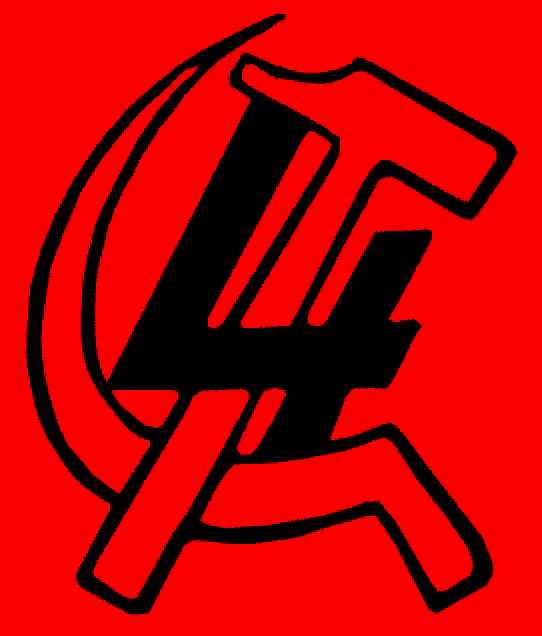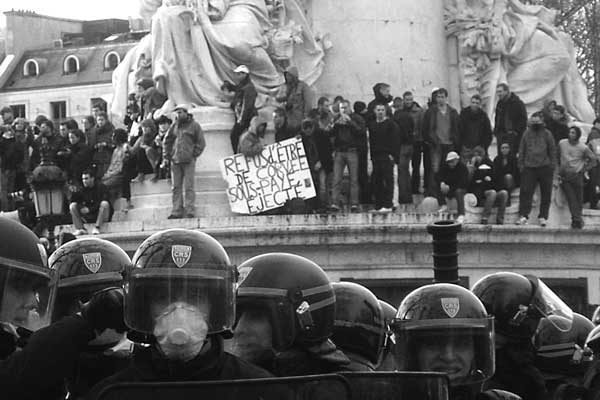
April 2006
No Collaboration – Cops Out of the Unions!
Demonstrators
Demand:
“Free Our Comrades!”

After more than two months in the
streets, mobilizations are continuing across France against the vicious
law
establishing a “First Employment Contract” (CPE) that would let
employers
dismiss young workers (age 26 and under) without cause for up to two
years.
After the mammoth marches which brought out millions to protest, youth
and
workers together, the initiative has shifted to “operations coup de
poing”
(“sock it to ’em,” or quick strike actions) in which protesters
converge on a
road or rail line to halt traffic.
On Thursday,
April 6, a couple hundred demonstrators blocked the rails at Paris’
Gare de
l’Est in the early morning; the crowd growing to 500 moved on
Saint-Lazare
station, a commuter train depot. swelling to more than 5,000. The
protest then
headed to the Garde du Nord, where for an hour and a half they shut
down rail
traffic, holding a picnic on top of a Thalys express train. While
students
called for “hugs and kisses,” the police responded with riot clubs. At
Orly
airport outside Paris, access roads were blocked by scores of
protesters. On Friday,
students attempted to “hold the Council of State for questioning,”
while scores
of sans-papiers (undocumented immigrants) sat down outside La
Santé
prison.
Meanwhile, caravans of CRS riot police
race around Paris with sirens blaring,
occupying the Latin Quarter, sealing off the National Assembly, even if
no
demonstrations are in sight, mainly intending to intimidate. Throughout
France
the mobilization has continued. On Thursday, in Caen (Normandy) in the
northwest, more than 2,000 occupied the railroad station, while
hundreds of
demonstrators cut off rail lines at Toulouse in the south, where
students and
unionists blocked roads into Airbus airplane factories. Rail lines were
also
blocked for hours by hundreds of demonstrators in Narbonne and Lille,
and
highways and turnpikes were blockaded outside Nantes, Rennes,
Strasbourg,
Nancy, Clermont-Ferrand and elsewhere.
The principal demand of this round of
demonstrations was to end the repression and free hundreds of youths
being held
by the police. Altogether since the beginning of the protests, 3,682
people
have been held for questioning (interpellés) by the
police during and
after marches, more than 1,500 have been placed in police custody (garde
à
vue), and some 600 turned over to the courts for prosecution. More
than 220
have been judged in instant “trials,” often within 24 hours of their
arrest,
sometimes without a lawyer present to represent the accused. At least
60 have
already been sentenced to prison terms (from Libération,
5 April and L’Humanité,
7 April).
Similarly last fall, in the course of
22 days of ghetto youth “riots,” more than 3,100 people were put in
police
custody, 729 tried in on-the-spot trials and 422 convicted. Three out
of four
youths convicted for “acts of violence” (like throwing a bottle) were
sentenced
to prison (figures from Yann Moulier Boutang, La révolte des
banlieues, ou
les habits nus de la République [2005]). This procedure of
immediate trials
recalls what happened during the May 1968 revolt in Paris, which turned
the
call to “Free our comrades!” into a watchword of the movement. Now, as
the
minister of justice demands “a judicial response marked by rapidity and
firmness,” the same demand is echoing from one end of France to the
other.
The government and the police pretend that
mass arrests are the response of police to gangs of casseurs
(“smashers”) infiltrating the demonstrations, snatching cellphones and
MP3
players, beating photographers, and the like. This picture is utterly
false.
There were some highly publicized incidents of theft and random
violence by
bands of largely (but not exclusively) minority youth from the suburban
ghettos
during a March 23 protest and a few cases since. Students from various
schools
have since formed contingents with their own marshals to avoid or
minimize such
occurrences. But the arrests have overwhelmingly come at the end of the
marches
as riot cops use force to disperse demonstrators, deliberately
provoking
violence.
The smell of police provocation is
heavy in the air as clouds of tear gas waft over the protests. In the
March 28
demonstration in Paris, television cameras caught plainclothes
policemen
wearing stickers of the Ligue Communiste Révolutionnaire (LCR)
mixing in with
marchers. LCR marshals confronted them and demanded that the undercover
cops
remove the badges. Yet a few hours later the same squads were again
sporting
LCR, Lutte Ouvrière, CNT (anarchist) and other union stickers on
their jackets.
In addition, a number of cops put on dreadlock wigs to disguise their
presence
(Le Monde, 5 April). Several of the photographers were beaten
not by casseurs
but by the police.
How the cops seek to instigate violence could
be seen
on March 28. At the end of the march at Place de la République,
demonstrators
were effectively trapped, with four of the six streets leading out of
the
square sealed off by police vehicles mounted with metal grating such as
used to
protect G-8 meetings from anti-“globalization” protesters. This left
thousands
of people milling about in the large square. Squads of cops would
periodically
charge into the crowd to grab some youths. After a while, lines of
police began
pushing demonstrators back (although they had nowhere to go, since the
huge
crowd was still arriving and there was no outlet). Hundreds of cops
were
surrounding the square, and as dusk fell a water cannon was used to
drench the
demonstrators.
Union Marshals Do Cops’
Dirty
Work
After the previous big demo, on March
18, where a similar police corral led to a couple of cars getting
trashed,
there was controversy over Interior Minister Sarkozy’s plan to send cop
“snatch
squads” into the demonstration to grab “troublemakers.” Union officials
objected, and said their service d’ordre (marshals squad) would
take
care of things inside the demo. But, outrageously, what this meant in
practice
was the union marshals doing the cops’ dirty work. According to a
report in Libération (29 March) CGT union goon squads
went after some gangs of
mostly black and
Arab youths from the heavily immigrant poor and working-class suburbs:
“Suddenly the CGT [union
federation] pounces on some ‘z’y va’ [referring to bands of
ghetto
youths], leading with fists, kicks and billy clubs. The ‘rogues’ take
some
heavy blows. The marshals squad of the CGT Printers Union finishes the
job by
handing over the troublemakers to the gendarmes stationed on the main
streets
leading into Place de la République. The collaboration was
prepared by the
Ministry of the Interior, the Paris Police Prefecture and the union
marshals’
squads.”
 CGT and other unions
ordered their marshals to go after “troublemakers.” Union goons beat youths
with sticks and turned them over to police. (Photo:
thibautcho.free.fr)
CGT and other unions
ordered their marshals to go after “troublemakers.” Union goons beat youths
with sticks and turned them over to police. (Photo:
thibautcho.free.fr)
The next day, L’Humanité (30
March), the mouthpiece of the Communist
Party, bragged that “Union marshals and police deployment were able to
control
violence along the line of march.” The article continued: “At 5 p.m. a
line
consisting of plainclothes police and union marshals diverts
demonstrators arriving
at the square. Separate anti-CPE militants and those looking for a
fight. ‘We
got them like in a mousetrap,’ explained Joaquin Masanet,” head of the
UNSA
police “union.” More than 500 people were seized by the police that
day, “a
mixture of overdressed youths, anarchist militants, bystanders and
journalists,” admits L’Huma.
This is a disgusting case of the union
bureaucracy acting as deputy sheriffs for the machinery of capitalist
state
repression. It recalls how in the late 1970s the Italian Communist
Party acted
as finger men for the bourgeoisie against the Red Brigades and union
militants
in the factories. This is a graphic expression of what the “popular
front”
means in practice: the reformist, pro-capitalist left acting as guard
dogs for
the ruling class. This is the logic of organizing “unions” of police,
the armed
fist of the bourgeoisie. In contrast, revolutionaries demand: Cops
out of
the unions! Release all those arrested in connection with the protests
against
the CPE! Drop all charges and annul all sentences against those
arrested at
anti-CPE protests and during the youth revolt in the suburbs last fall.
The authorities are trying to set poor
immigrant youth and white middle-class youth against each other. The
oppressors
fear that if those they oppress come together in an explosion of
discontent
with working-class support it could threaten the regime. Yet what their
heavy-handed tactics have achieved is to educate a new generation of
youth in
the harsh realities of the class struggle. Hundreds of thousands of
youths have
seen which side the cops are on.
Now the government wants to
institutionalize its heavy-handed repression. A bill introduced on
March 29 by
Eric Raoult seeks to reintroduce key provisions of the 1970 “anti-casseurs” law, which was abrogated in
1981 for contradicting the fundamental judicial principle of individual
responsibility. Today “collective guilt” is back. Under the bill,
organizers of
demonstrations where there is violence against persons, or “destruction
or
damage caused to property” could be jailed for up to two years, even if
they
had nothing to do with the alleged actions. In addition, protest
organizers who
fail to order that the demo disperse after such destruction could also
be
jailed, as well as individuals who continued to participate in the
gathering.
After ordering a “state of emergency”
during the youth revolt last year, the government of the aging Gaullist
warhorse Chirac, his would-be Napoleonic prime minister de Villepin and
top cop
Sarkozy is reaffirming its bonapartist appetites. While the reformist
left
yearns for a new “popular front” of class collaboration, the response
to
mounting repression must be to organize mass mobilization of the
working class.
Already several regional union bodies have called for a general strike.
Councils of workers and students should be organized to prepare and
carry out sustained
strike action, locally, regionally and nationally. The only solution is
a
struggle for workers revolution, to sweep away the bourgeoisie’s
corruption and
violence for good. n
To contact the Internationalist Group and the League for the Fourth International, send e-mail to: internationalistgroup@msn.com